DVB-S2 HDL Transmitter
This example shows how to implement a digital video broadcast satellite second generation (DVB-S2) transmitter using Simulink® blocks that are optimized for HDL code generation and hardware implementation.
From this example, you can generate a DVB-S2 transmitter waveform using these steps:
Generate a baseband frame (BBFRAME).
Encode using Bose-Chaudhuri-Hocquenghem (BCH) and low-density parity-check (LDPC) codes.
Interleave, modulate, and generate a physical layer frame (PLFRAME).
Insert dummy frames.
Pulse shape the symbols in frames using a root raised cosine (RRC) filter.
Model Architecture
The BBFRAME Generator block generates BBFRAME from the user packets. The FECFRAME Generator block encodes the BBFRAME using BCH and LDPC coding, and interleaves the encoded frame to generate an FECFRAME. The Symbol Modulator block generates the xFECFRAME by mapping the FECFRAME bits to modulation symbols. The PLFRAME Generator block generates the PLHEADER, pilot symbols, and dummy frames, and multiplexes them with the xFECFRAME bits. The PL Data Scrambler block scrambles the multiplexer output to generate a PLFRAME. The RRC Filtering block pulse shapes the PLFRAME symbols to generate the transmitter waveform.

This figure shows the transmitter frame structure.

File Structure
This example uses supporting files.
dvbs2hdlTransmitter— Model for DVB-S2 HDL transmitter.dvbs2hdlTransmitterCore— Model reference for the transmitter design.dvbs2hdlTxParameters— Functions that generates parameters for thedvbs2hdlTransmitterCoremodel.dvbs2hdlTxInit— Script that initializes thedvbs2hdlTransmittermodel.dvbs2hdlTransmitterVerify— Script that generates reference transmitter waveform usingdvbs2WaveformGenerator(Satellite Communications Toolbox) function and compares the reference waveform with the simulated transmitter output.
System Interface
The figure shows the top-level overview of the dvbs2hdlTransmitter model.

Model Inputs
pktBitsIn — Input packet bits, specified as a Boolean scalar.
pktStartIn — Control signal indicating the start of each packet, specified as a Boolean scalar.
pktEndIn — Control signal indicating the end of each packet, specified as a Boolean scalar.
pktValidIn — Control signal indicating whether the pktBitsIn is valid, specified as a Boolean scalar.
frameStartIn — Control signal indicating the start of each frame, specified as a Boolean scalar.
frameEndIn — Control signal indicating the end of each frame, specified as a Boolean scalar.
TSorGS — Input stream format, specified as a 2 bit unsigned real integer.
DFL — Data field length (DFL), specified as a 16 bit unsigned real integer.
UPL — User packet length (UPL), specified as a 16 bit unsigned real integer.
SYNC — SYNC word, specified as a 8 bit unsigned real integer.
MODCOD — MODCOD, specified as a 5 bit unsigned real integer.
FECFrame — FECFrame type, specified as a Boolean scalar.
Model Outputs:
dataOut — Transmitter output, returned as a 18 bit complex scalar.
validOut — Control signal indicating whether the dataOut is valid, returned as a Boolean scalar.
flag — Status signal to compute number of dummy frames and real frames in the transmit waveform, returned as a 2 bit real scalar.
ready — Control signal indicating whether the transmitter is ready for the input, returned as a Boolean scalar.
Model Structure
This figure shows the structure of the DVB-S2 HDL transmitter subsystem. The subsystem comprises BB Frame Generator, FEC Encoder, DVB-S2 HDL Interleaver, Symbol Modulator, PL Frame Generator, PL Data Scrambler, and RRC Transmit Filter subsystems.

BB Frame Generator
The BB Frame Generator subsystem comprises BB Header and Data CRC Generator, Data Store FIFO, Multiplexer, and BB Scrambler subsystems. The BB Header and Data CRC Generator subsystem generates BB header, discards the SYNC bits, appends CRC bits to each packet using the General CRC Generator HDL Optimized block, and appends padding bits to the data field for each frame. The Data Store FIFO subsystem stores the data field of each frame in a RAM buffer and reads it out after the BB header. The Multiplexer subsystem multiplexes the BB header and data field. The BB Scrambler subsystem scrambles the BB header and data field to generate a BBFRAME.
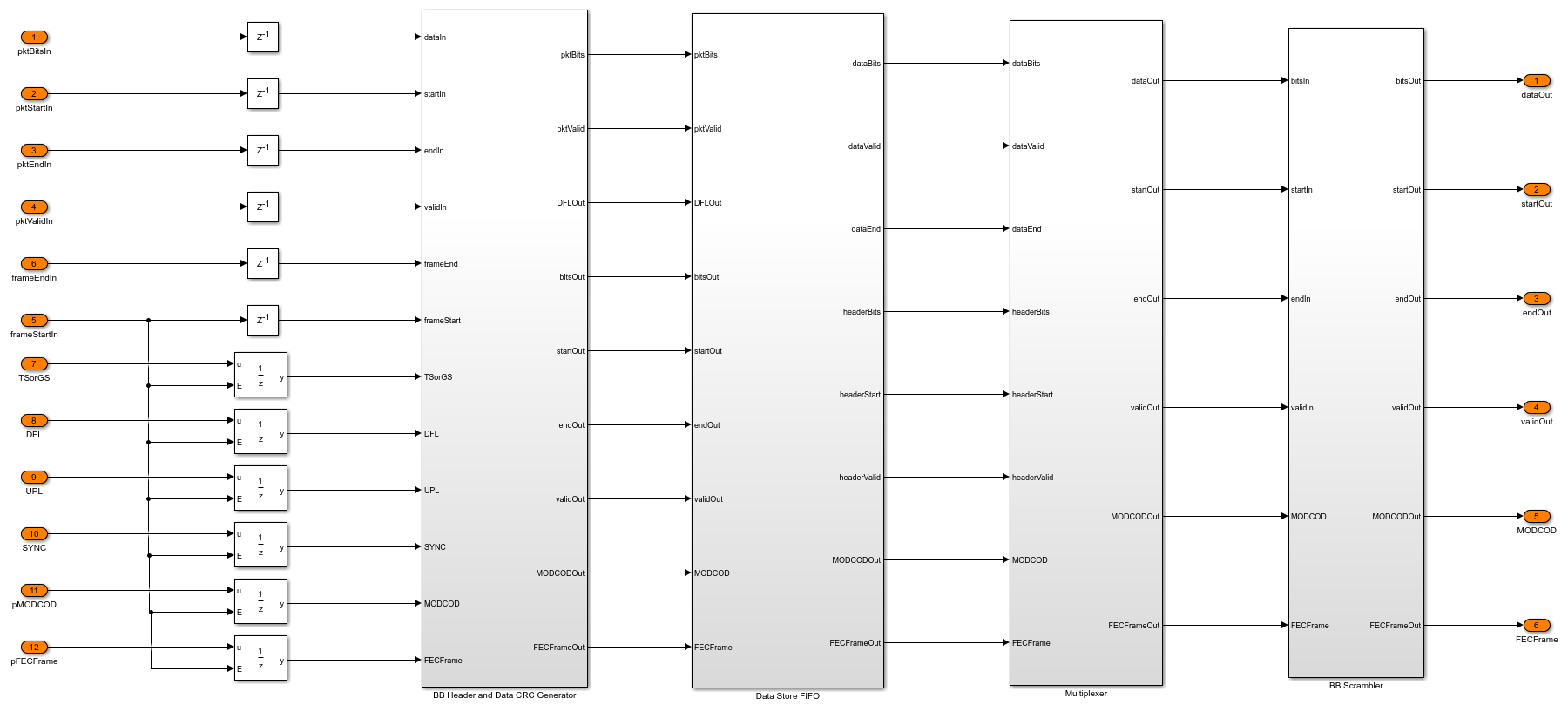
FEC Encoder
The FEC Encoder subsystem encodes the input bits with BCH Encoder subsystem followed by LDPC Encoder subsystem. For more information, see DVB-S2 HDL BCH Encoder and DVB-S2 HDL LDPC Encoder examples.
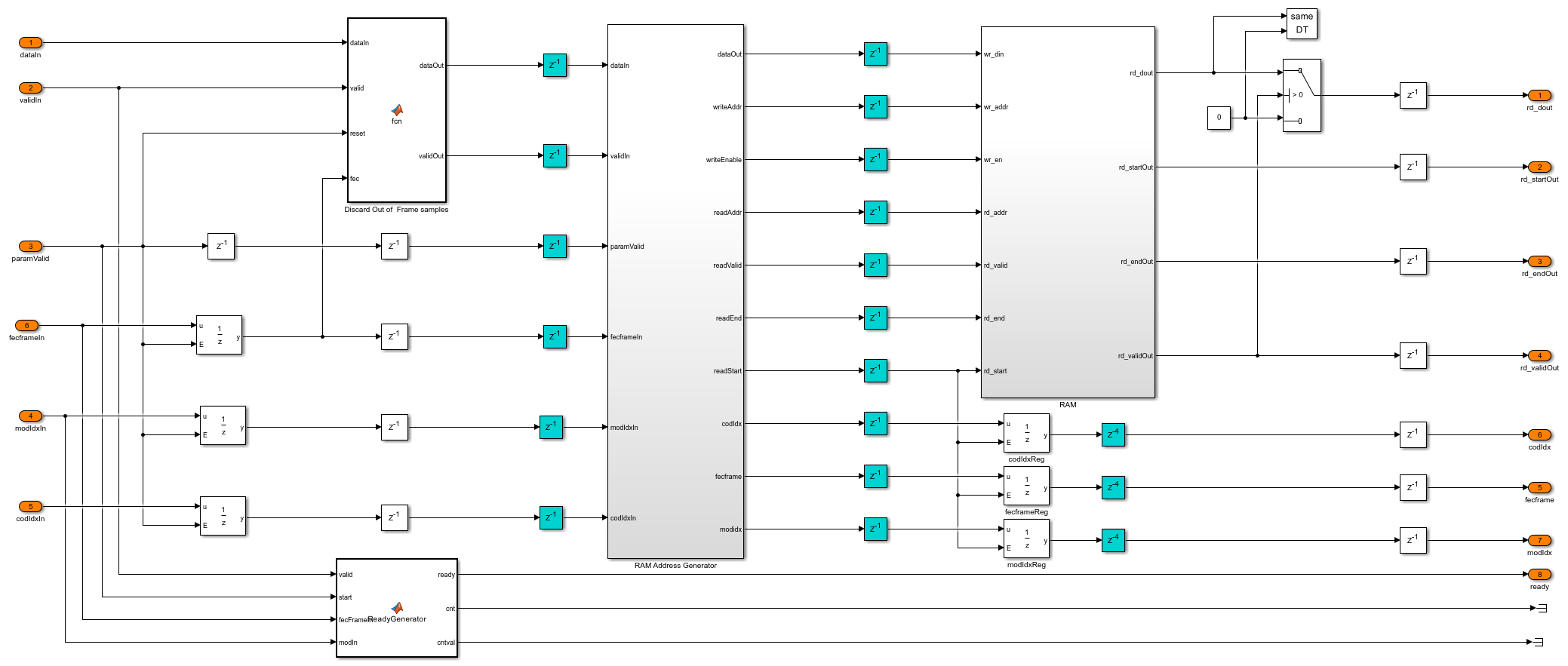
DVB-S2 HDL Interleaver
The DVB-S2 HDL Interleaver subsystem stores encoded bits from the LDPC Encoder subsystem inside the RAM subsystem. The RAM Address Generator subsystem generates read and write addresses for the RAM for interleaving.

In the RAM Address Generator subsystem, the nRows and nColumns subsystem stores the number of rows and columns of each possible configuration in lookup tables (LUT). Based on the MODCOD and FECFrame parameters, the subsystem determines the number of rows and columns for interleaving. The Read Offset Address subsystem generates the interleaver indices of each frame as an offset address. The subsystem reads only two bits are read for QPSK, three bits for 8-PSK, four bits for 16-APSK, and five bits for 32-APSK every eight time steps. This process ensures that each symbol covers eight time steps of the interleaver, which is equal to one symbol duration. The Generate and Add Read Base Address subsystem adds the offset address with a base read address to get the address of the bits that are stored in the RAM. The Parameter Store FIFO subsystem stores the parameters and reads them at the start of each frame.
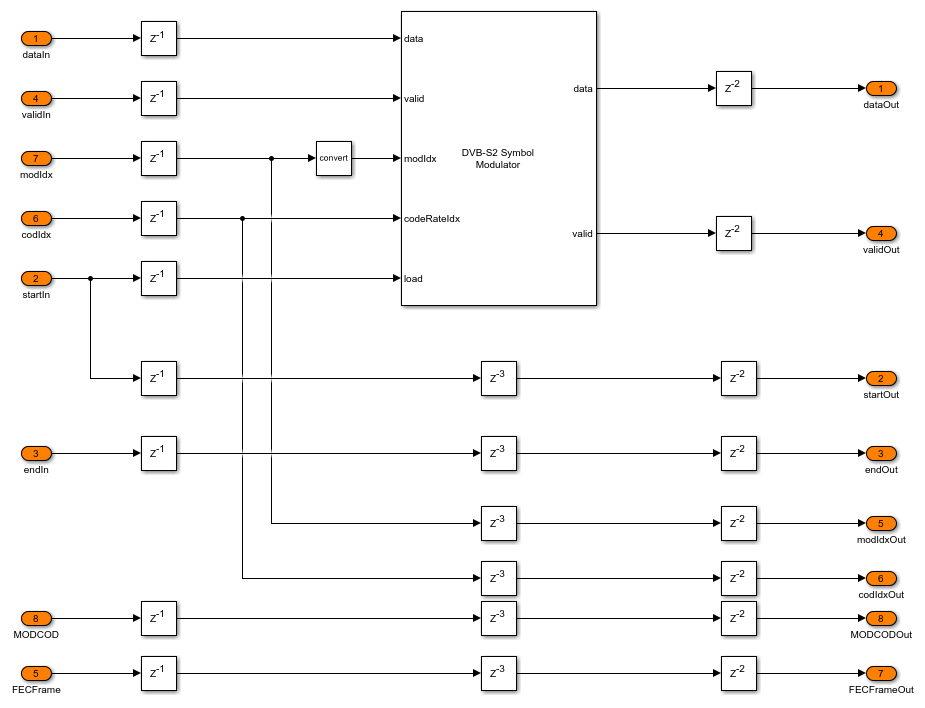
This table shows the rows and columns for deinterleaving in each of the configurations.
Modulation Rows (Normal) Rows (Short) Columns
__________ _____________ ____________ _______
QPSK 64800 16200 1
8-PSK 21600 5400 3
16-APSK 16200 4050 4
32-APSK 12960 3240 5
Symbol Modulator
The Symbol Modulator subsystem comprises DVB-S2 Symbol Modulator block that maps the input bits to the corresponding modulation symbols.
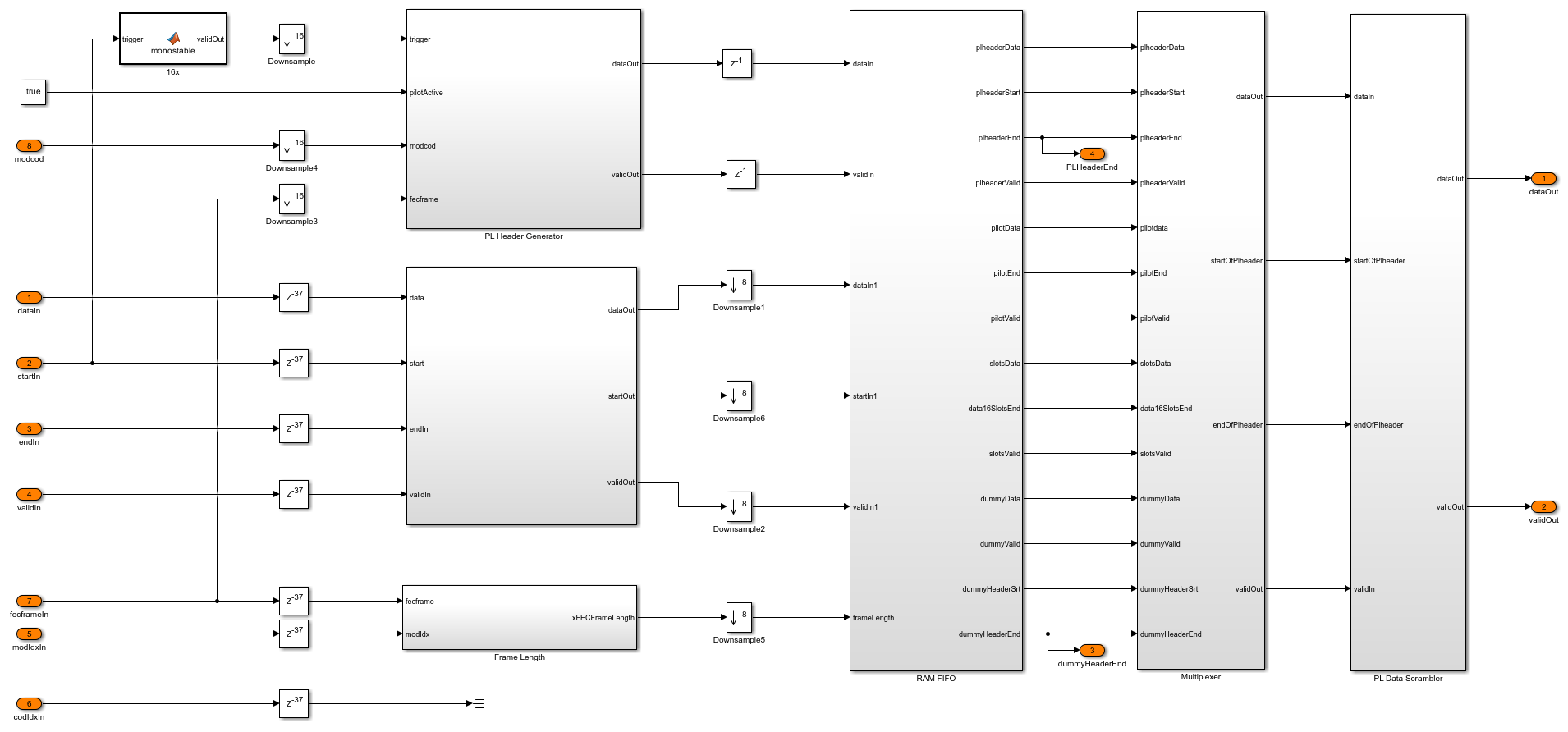
PL Frame Generator
The PL Frame Generator subsystem stores the modulated symbols in the RAM FIFO subsystem. The PL Header Generator subsystem generates the PLHEADER for each frame and stores it in the RAM FIFO subsystem. When symbols corresponding to a frame are ready in the RAM, the PL Frame Generator subsystem outputs the PLHEADER, pilot symbols, and data symbols according to the frame structure specified in [ 1 ]. When the symbols corresponding to a frame are not ready, the Dummy Frame Generator subsystem inside the RAM FIFO subsystem outputs dummy frames. The Multiplexer subsystem multiplexes the PLHEADER, pilot symbols, data symbols, and dummy frames to generate a unscrambled PLFRAME. The PL Data Scrambler subsystem scrambles the data field excluding the PLHEADER. The scrambling starts after the PLHEADER of each frame and continues until the end of the frame.

RRC Transmit Filter
The RRC Transmit Filter subsystem upsamples the input by a factor of four and uses the Discrete FIR Filter block with an RRC impulse response to pulse shape the PLFRAME symbols.

Run Model
Set the symbol rate, MODCOD, FECFrame type, input stream format, and user packet length on the mask of the Input Configuration subsystem and run the dvbs2hdlTransmitter model. Set the same symbol rate for the Input Configuration subsystem in the dvbs2hdlTransmitter model, the DVB-S2 Tx subsystem of the dvbs2hdlTransmitterCore model reference. Alternatively, execute this command at the MATLAB Command Window to run the model.
sim dvbs2hdlTransmitter
The MODCOD and FECFrame must be row vectors. Each element of the row vectors corresponds to the values of MODCOD and FECFrame in a frame.
Verification and Results
Run the model to display the transmitter spectrum, error plot between the reference waveform and simulation output, and relative mean squared error of the simulation output.
### Searching for referenced models in model 'dvbs2hdlTransmitter'. ### Total of 1 models to build. ### Starting serial model build. ### Successfully updated the model reference simulation target for: dvbs2hdlTransmitterCore Build Summary Model reference simulation targets: Model Build Reason Status Build Duration ================================================================================================================================= dvbs2hdlTransmitterCore Target (dvbs2hdlTransmitterCore_msf.mexw64) did not exist. Code generated and compiled. 0h 6m 9.2092s 1 of 1 models built (0 models already up to date) Build duration: 0h 6m 14.893s Simulation Completed. Running verification script... Relative mean squared error (dB) between the simulink output and reference = Real: -79.6448 Imag: -79.6563

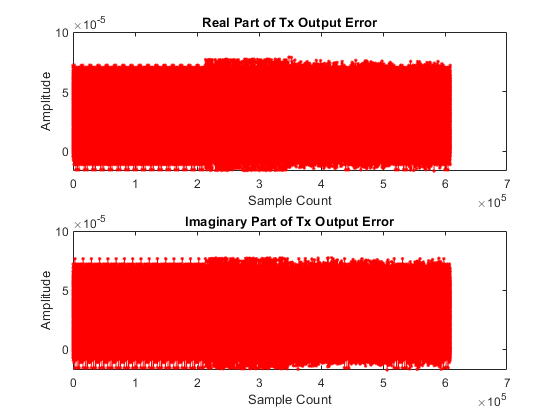
HDL Code Generation
To generate the HDL code for this example, you must have HDL Coder™. Use makehdl and makehdltb functions to generate HDL code and HDL test bench for the DVB-S2 HDL transmitter subsystem. The test bench generation time depends on the simulation time.
The resulting HDL code is synthesized for a Xilinx® Zynq® UltraScale+ RFSoC ZCU111 board. This table shows the post place and route resource utilization. The maximum frequency of operation is 365 MHz.
Resources Usage
_____________ _____
CLB LUT 10701
CLB Registers 9024
RAMB36 99
RAMB18 6
DSP48 42
References
ETSI EN 302 307-1. Digital Video Broadcasting (DVB); Second Generation Framing Structure, Channel Coding and Modulation Systems for Broadcasting, Interactive Services, News Gathering and other Broadband Satellite Applications (DVB-S2).
ETSI TR 102 376-1. Digital Video Broadcasting (DVB); Implementation Guidelines for the Second Generation System for Broadcasting, Interactive Services, News Gathering and other Broadband Satellite Applications (DVB-S2).
See Also
Blocks
Functions
dvbs2WaveformGenerator(Satellite Communications Toolbox)